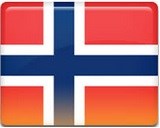
 geologisk kart over området
geologisk kart over området
Forekomster av putelava-grønnstein mange steder i Trondhjemsområdet viser at nesten alle bergartene fra Bymarka til Lade til Vassfjellet opprinnelig ble dannet av undersjøiske lavastrømmer i et hav som nå er blitt borte. Etter at lavaene hadde størknet som bergarter, trengte nye smeltemasser (av trondhjemitt) inn i dem. Senere er disse tørre størkningsbergartene noe omdannet i kontakt med varmt grunnvann i jordens skorpe.
 putelava - pillow lava
putelava - pillow lava
Ved GZ kan vi observere et uregelmessig mønster, som kalles putestruktur. Slik struktur er dannet når lava renner ut og størkner under vann - en undersjøisk lavastrøm. Putelava er basaltisk lava som størkner under vann, og dermed utvikler en putestruktur. Putene er runde masser av bråavkjølt stein, de ligger tett inntil hverandre. På grunn av den store forskjellen i temperatur mellom lavaen og vannet rundt størkner putene så kjapt at de sjelden rekker å bli mere enn en meter i diameter. Slike puter dannes vanligvis ved avkjøling av lava under vann og er kjent fra midthavsryggene og andre magmatiske miljøer. Putelava dannes når mafisk til intermediær lava kommer til overflaten og avkjøles raskt slik at det dannes en lava tube med en tynn ytre glassaktig glatt hinne. Når trykket i lavatuben blir for stort sprekker glasshinnen, slik at en ny lavatube kan dannes. Den raske størkningstiden gjør at det bli en glatt og finkorning konveks hinne på overflaten. Lavaen inni puten størkner senere, men likevel rask nok til at det etableres en finkornig stuktur. Denne prosessen medfører at det dannes et nettverk av tuber som ofte har et putelignende tverrsnitt.
Putelave lages undervann og under isbreer og er en klassisk indikator på at bergarten er dannet under vann.
Putelave kan brukes som en way-up indicator i den forstand at man kan bruke putelave til å etablere hva som var vertikale aksen for den formasjonen man studerer i det den bla dannet, dvs før folding. Det er minst to ideer man kan forfølge for å vise at putelave angir opprinnelig oppoverretning for formasjonen.
- Putelavaens oppside har en konveks (oppoverpekende) overflate.
- Putene brer seg ut på nedsiden med en konisk form.

Pillow lavas are bulbous, spherical, or tubular lobes of lava. Pillow lavas are created when magma reaches the surface but, as there is a large difference in temperature between the lava and the ambient water, the surface of the emergent tongue cools very quickly, forming a smooth skin. The tongue continues to lengthen and inflate with more lava, forming a lobe, until the pressure of the magma becomes sufficient to rupture the skin and start the formation of a new eruption point nearer the vent. This process produces a series of interconnecting lobate shapes that are pillow-like in cross-section. The skin cools a lot faster than the inside of the pillow, so it is very fine grained, with a glassy texture. The magma inside the pillow cools more slowly, so is slightly coarser grained than the skin, but still classified as fine grained.
The pillows are rarely more than one metre in diameter and in cross-section each one has a convex upper surface, radial and concentric fractures, and commonly a central cavity or tube which once fed lava to the front of the advancing finger.
Pillow lavas are found not only in the ocean but also under glaciers that overlie volcanoes. They are a classic geological indicator that the area you are standing in was once under water. Pillow lavas are a very common eruption product, especially on seamounts, so understanding something about the conditions under which they form can help us understand how seamounts form.
Pillow lave occurs wherever mafic to intermediate lavas are extruded under water, such as along marine hotspot volcano chains and the constructive plate boundaries of mid-ocean ridges. As new oceanic crust is formed, thick sequences of pillow lavas are erupted at the spreading center fed by dykes from the underlying magma chamber. Pillow lavas and the related sheeted dyke complexes form part of a classic ophiolite sequence when a segment of oceanic crust is obducted onto continental crust. The term mafic is used describing a silicate mineral or rock that is rich in magnesium and iron. Most mafic minerals are dark in color, and common rock-forming mafic minerals include olivine, pyroxene, amphibole, and biotite. Common mafic rocks include basalt, dolerite and gabbro.
Pillow lavas are used as way-up criterion in geology. There are two key ideas that can be used as part of this, and that a pillow lava will show if it is the correct way-up:
- The pillow structures will show a convex upper surface.
- The pillows will have a tapered base downwards as they have moulded to the underlying pillows during their formation.
Please email me any suggestions for improvements, corrections or additions to the text of this cache.
Vennligst email meg forslag til korreksjoner og forbedringer til denne cachen.
Send the answers by e-mail via the cache owner's profile page on Geocaching.com. You can log immediately after you have emailed me your answers.
Send svarene på spørsmålene via min email. Du kan logge straks etter at du emailet meg svarene på spørsmålene.
Logs without answers emailed to CO or with pending questions from CO will be deleted without any further notice.
Logger uten at jeg har mottatt svar på spørsmålene blir sletter uten forvarsel.
Gå til GZ og besvar følgende spørsmål/Walk to GZ and answer the following questions:

GZ
Spørsmål/Questions:
- Which at least three key properties of pillow lava can you observe at the site. Hvilken tre viktige egenskaper for lavaputer kan du observer ved GZ.
- Putelava kan brukes for å indikere hva som var horisontalretning før bergarten ble forkastet og rotert. I hvor mange grader fra horisintalplanet antar du denne putelavaen er rotert? Pillow lavas are used as way-up criterion in geology. How many degrees relative to a vertical axis do you estimate that the pillow lavas at GZ are tilted.
- OPTIONAL. Ta et bilde av deg eller din GPS ved site uten å røpe svarene på spørsmålene over. Take a picture of your or your GPS at the site without revealing any of the answers to the questions above.
Sources: Wikipedia and http://folk.ntnu.no/krill/Korsvika.htm